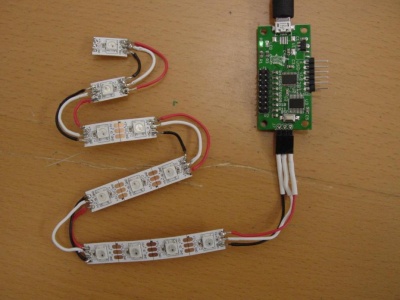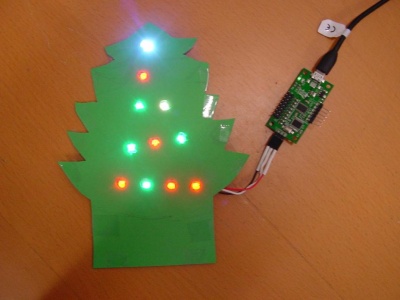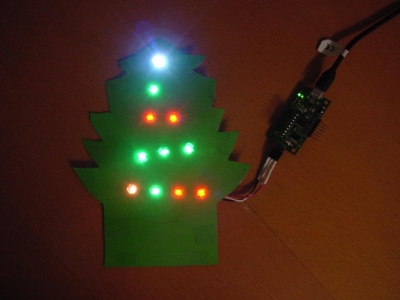Difference between revisions of "Blog 24"
| Line 37: | Line 37: | ||
After that you can send it to the ws2812 with: |
After that you can send it to the ws2812 with: |
||
./randomname > /dev/ttyACM1 |
./randomname > /dev/ttyACM1 |
||
== Resetting the WS2812 == |
== Resetting the WS2812 == |
||
Revision as of 09:48, 8 January 2016
Connecting the WS2812
First you just have to connect the WS2812 with a micro-USB cable to your device.
You have to use C-kermit or PuTTY:
For Linux/Raspberry:
apt-get install ckermit
If you use an other device, or want to know more:
C-Kermit
For Windows users it's optional to use:
PuTTY
On a UNIX device, when you want to run the code from the device to the WS2812. You have to type in the terminal:
/usr/bin/kermit -l /dev/ttyACM0
It could be that you have to send to/from an other destination.
It will then say C-kermit is opened. You then just have to type the letter:
c
It will tell you to turn off carrier watch with:
SET CARRIER-WATCH OFF
If you don't want to ask this every time you start up with c. You can make a new terminal and write:
nano .kermrc
That file(.kermrc) should only have the code:
SET CARRIER-WATCH OFF
When the carrier-watch is off you have to type c again.
Before you send a code to the ws2812 check it with:
gcc -Wall -o randomname randomname.c
After that you can send it to the ws2812 with:
./randomname > /dev/ttyACM1
Resetting the WS2812
Maybe you will get the experience that the ws2812 crashed and has to be resetted. When the RGB leds are still attached they will get a rainbow effect. To reset the WS2812 you have put a male-female cable on pin 5 on the horizontal connector. The male part of the connector should then hit the ground once. After that you can do the previous commands and everything should work fine again.
RGB lighted paper Tree
Hardware used:
Software used on my linux pc:
- C-kermit
Making the construction
The RGB leds:
The image pretty much explains itself. What you have to do is connect RGB with the 3-pin header.( GND - pin 1 | DO - pin 2 | +5V - pin 3 ) The pointers of this example RGB strip should be pointing away from the WS2812 usb controller.
Paper tree: The paper tree is made by folding a green paper. On the folded green paper I put my RGB led connection. Around the RGB led I drew a Christmas tree. At the points where every single RGB led were laying I put a dot by using a pencil. After that I cut the tree out and made holes at the pencil dots. After that I used some scotch tape to bring the front and back paper together. The final result:
You can of course go all crazy with the tree by adding glitters and stuff like that.
The code
The full c-program RGBTree.c can be downloaded: here.
What the code does in short is this: When starting up it will make the the peak RGB led white. It will then read the for statement where it goes through all the RGB leds(Except the peak). Every RGB led will randomly get the color green or red. The script will then keep fading the colors of the RGB leds to the opposite color. ( red to green or green to red )
The parts of the script that I will give some explanation:
Here I made a list of colors(if you also want other colors search for: color table):
#define WHITE 0xffffff #define YELLOW 0xffff00 #define RED 0x800000 #define GREEN 0x008000 #define BLUE 0x0000ff #define BLACK 0x000000
Because it's RGB ( red green blue ) the first two zeros can be used for changing the the amount of red color. The middle two zeros are for the amount of green and the last two are for blue. With this you can mix the colors and make different colors.
Here the amount of time and steps in milliseconds is given for to make the fading go fluent.
int nfadesteps = 30; int delayms = 30;
In interpolate it will get the values from fadeto three times ( for every color r, g & b ) It will give new values to c1 and c2 it will bit shift it to the right, and give it the value together with 0xff. After that it calculates difference between previous color.
int interpolate (int c1, int c2, int shift, int pos, int end)
{
c1 >>= shift;
c2 >>= shift;
c1 &= 0xff;
c2 &= 0xff;
return c1 * (end-pos) / end + c2 * pos / end;
}
Void fadeto receives the information from int main for example: (5, RED, GREEN). It will give the information to every single part of the rgb led. So in this example it would be that red will change from 80 to 00. it will keep doing calculations of the steps until it reached 30(nfadesteps). After that it prints out on the certain RGB led that given color values.
void fadeto (int pixnum, int col1, int col2)
{
int i;
int r, g, b;
for (i=0;i <= nfadesteps;i++) {
r = interpolate (col1, col2, 16, i, nfadesteps);
g = interpolate (col1, col2, 8, i, nfadesteps);
b = interpolate (col1, col2, 0, i, nfadesteps);
printf ("pix %d %06x\n", pixnum,
(r << 16) | (g << 8) | (b << 0));
usleep (delayms*1000);
}
}
After that the peak led will get white.
int main (int argc, char **argv)
{
int nleds = 10;
int *pixels;
int pixnum, newcolor;
int i;
if (argc > 1)
nleds = atoi (argv[1]);
pixels = calloc (nleds, sizeof(int));
printf ("pix %d %06x\n", nleds, WHITE);
The for statements is the first loop that is getting used. It will count from zero till nine. Every time it counts it will get a random number and use a remainder to divide it with. The result could be a zero or an one. If it is zero the color red will be given else it would be green. After that it will directly be printed, so that i can be changed to the next number.
for (i=0;i < nleds;i++){
if (random () % 2 == 0)
pixels[i] = RED;
else
pixels[i] = GREEN;
printf ("pix %d %06x\n", i, pixels[i]);
}
In the while statement it has to choose a random led. It does this by giving a random number and remainder it with nleds. If it then has chosen the certain led it will look if the led is red. If that is true it will say that the newcolor has to become green. Else the opposite will happen, so that the led will become red. The given values will then be sended to fadeto. ( Example: (5, RED, GREEN). After that it will save the newcolour in the previous led color. so pixels[05] would become green.
while (1) {
pixnum = random () % nleds;
if (pixels[pixnum] == RED)
newcolor = GREEN;
else
newcolor = RED;
fadeto (pixnum, pixels[pixnum], newcolor);
pixels[pixnum] = newcolor;
}
exit (0);
}


